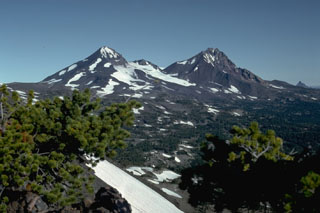Report on Three Sisters (United States) — December 2005
Bulletin of the Global Volcanism Network, vol. 30, no. 12 (December 2005)
Managing Editor: Richard Wunderman.
Three Sisters (United States) Uplift continues during 2005, but at perhaps half the previous rate
Please cite this report as:
Global Volcanism Program, 2005. Report on Three Sisters (United States) (Wunderman, R., ed.). Bulletin of the Global Volcanism Network, 30:12. Smithsonian Institution. https://doi.org/10.5479/si.GVP.BGVN200512-322070
Three Sisters
United States
44.133°N, 121.767°W; summit elev. 3159 m
All times are local (unless otherwise noted)
According to the U.S. Geological Survey, field surveys indicated that the uplift of the broad area in the Three Sisters region of central Oregon, gradually swelling since late 1997 (BGVN 26:05), continued as of 14 December 2005. However, the swelling may have slowed somewhat during the past year.
The area of uplift is 20 km in diameter and is centered 5 km W of South Sister volcano. The middle of the uplift rose at an average rate of 2.5 cm per year as a result of intrusion of a modest volume of magma 7 km below the ground surface. Seismic activity related to the uplift has been scant, except for a swarm of more than 300 small earthquakes in late March 2004 (BGVN 29:06). Volcanic gases released from the intruding magma dissolve in ground water so water in local springs and streams is slightly enriched in chemical components derived from volcanic gases. Scientists believe that periods of intrusion similar to the present one have occurred in the area before. The duration and outcome of the current episode are considered to be impossible to forecast, and only continued monitoring will show whether or not this episode of intrusion is slowly ending.
Investigations during 2005 showed the following. (1) Earthquakes continued at a low rate?only five were located in the uplift area in 2005; these were small, up to M1.5. (2) The chemical composition of local spring and stream water remained unchanged from that of the past 5 years. (3) Uplift of the ground surface continued, but seems to have slowed from the rate observed in past years. The three techniques used to measure ground deformation, all having a degree of uncertainty, together suggest that the rate decreased in 2004-2005, perhaps by as much as one half. If so, the rate of intrusion of magma has declined as well.
Geological Summary. The north-south-trending Three Sisters volcano group dominates the landscape of the Central Oregon Cascades. All Three Sisters stratovolcanoes ceased activity during the late Pleistocene, but basaltic-to-rhyolitic flank vents erupted during the Holocene, producing both blocky lava flows north of North Sister and rhyolitic lava domes and flows south of South Sister volcano. Glaciers have deeply eroded the Pleistocene andesitic-dacitic North Sister stratovolcano, exposing the volcano's central plug. Construction of the main edifice ceased at about 55,000 yrs ago, but north-flank vents produced blocky lava flows in the McKenzie Pass area as recently as about 1600 years ago. Middle Sister volcano is located only 2 km to the SW and was active largely contemporaneously with South Sister until about 14,000 years ago. South Sister is the highest of the Three Sisters. It was constructed beginning about 50,000 years ago and was capped by a symmetrical summit cinder cone formed about 22,000 years ago. The late Pleistocene or early Holocene Cayuse Crater on the SW flank of Broken Top volcano and other flank vents such as Le Conte Crater on the SW flank of South Sister mark mafic vents that have erupted at considerable distances from South Sister itself, and a chain of dike-fed rhyolitic lava domes and flows at Rock Mesa and Devils Chain south of South Sister erupted about 2000 years ago.
Information Contacts: Cascades Volcano Observatory (CVO), U.S. Geological Survey, 1300 SE Cardinal Court, Building 10, Suite 100, Vancouver, WA 98683-9589, USA (URL: https://volcanoes.usgs.gov/observatories/cvo/).

